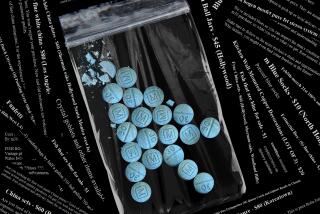Ecstasy Use Expands Beyond Clubs; Stiffer Sentences Ordered
WASHINGTON — Ecstasy, a drug once used primarily at nightclubs, has expanded beyond the club scene and is being sold at high schools, on the street and even at coffee shops in some cities, the White House drug policy office said Wednesday.
The availability of ecstasy has increased dramatically, and more blacks and Latinos are using the drug, the agency said in its biannual report that chronicles trends in drug use.
In response, the U.S. Sentencing Commission has increased penalties for those peddling large quantities of the drug, which sells for $10 to $45 per pill on the street.
Under temporary new guidelines, which federal judges must follow starting May 1, people the commission would consider local distributors--selling 800 pills or more--would be sentenced to more than six years in jail. That’s triple the time they would have gotten under previous guidelines.
Defense lawyers said the change makes ecstasy, on a per-dose basis, five times more serious to possess or sell than heroin and is excessive for a drug that is neither as harmful nor as addictive as heroin or cocaine. Some medical researchers also opposed the new guidelines.
“This is a wholly political act, not one based on scientific evidence,” said Edward Mallett, president of the National Assn. of Criminal Defense Lawyers.
But the chairwoman of the commission told senators Wednesday at a hearing on narcotics that ecstasy has serious and possibly long-term harmful affects.
“We have learned that ecstasy has unique pharmacological effects, physiological risks, user profiles, collateral consequences and trafficking patterns that make comparing ecstasy to other drugs of abuse very difficult,” Diana Murphy, commission chairwoman, told the Senate Caucus on International Narcotics Control.
Ecstasy’s chemical name is methylenedioxymethylamphetamine, or MDMA. A user usually experiences feelings of euphoria and increased desire to interact socially. Blood pressure, heart rate and body temperature increase dramatically.
While overall teenage drug use has either fallen or stayed level in recent years, ecstasy use has climbed. The White House report, presented at the hearing, showed that more than 80% of officials surveyed in 20 cities said ecstasy was more available than ever.
Nightclubs and dance parties known as “raves” are the most common venue for using ecstasy, but law enforcement officials, epidemiologists and drug treatment providers reported that the drug also was being sold at private parties, college campuses, high schools and on the street.
In New York, officials reported sales of ecstasy and other “club drugs” in shopping malls. In Washington, ecstasy was being sold in coffee shops, the report said.
“Use is no longer confined to the rave scene,” said Dr. Donald Vereen, deputy director of the drug policy office.
The guidelines will be effective for six months. The commission, an independent federal agency that sets national sentencing policy, can submit a permanent rule to Congress in May.
More to Read
Sign up for Essential California
The most important California stories and recommendations in your inbox every morning.
You may occasionally receive promotional content from the Los Angeles Times.










